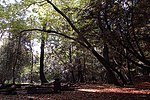Gane Pavilion
1936 establishments in EnglandBuildings and structures completed in 1936Buildings and structures in North SomersetFormer buildings and structures in BristolMarcel Breuer buildings ... and 1 more
Modernist architecture in England
The Gane Pavilion, also known as Gane's Pavilion, the Gane Show House and the Bristol Pavilion, was a temporary building designed by the modernist architect and furniture designer Marcel Breuer with F. R. S. Yorke and built in 1936 at Ashton Court near Bristol in England.
Excerpt from the Wikipedia article Gane Pavilion (License: CC BY-SA 3.0, Authors).Gane Pavilion
St Mary's Road,
Geographical coordinates (GPS) Address Nearby Places Show on map
Geographical coordinates (GPS)
| Latitude | Longitude |
|---|---|
| N 51.4479 ° | E -2.6446 ° |
Address
Ashton Court Golf Course
St Mary's Road
BS8 3PY
England, United Kingdom
Open on Google Maps








